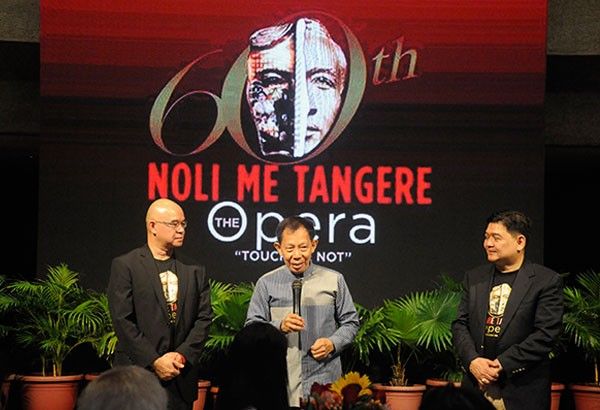‘Noli Me Tangere, The Opera’: When a classic is set to music

In our age, Rizal is less a shocking cult than he is an institution — or depending on which point of view, an industry — eternally interwoven into our lives by way of high school textbooks, pocket change, and the cool allure of graphic T-shirts. There has been many a high school lecture spinning the narratives of nationalism from the opus that is the Noli Me Tangere, until the supposed greatest Filipino novel ever written loses some of its valor in the wake of unending test exams.
The works of Rizal have been popularized and institutionalized both for nobler agendas and commercial gags. It is in theory a receptacle of the immortal Filipino spirit. Yet it has always remained just in theory. That is, until something like an opera interrupts the program.
In 1957, the Noli Me Tangere was set to music when National Artist Felipe de Leon wrote the Philippines’ first full-length opera based on the landmark novel, then set it to a libretto by Guillermo Tolentino, premiering at the Far Eastern University in the same year. And following runs at the Cultural Center of the Philippines, Resorts World Manila and tours abroad, the opera returns to the CCP this Jan. 28 to Feb. 3, for its 60th anniversary.
Two hundred opera singers, musicians, and crew are serenading the audience through the Italian operatic tradition with inflections of the Kundiman. Maestro Herminigildo Ranera leads the newly formed 53-piece Noli Symphony Orchestra, while stage, set, and costume designer Jerry Sibal debuts as director.
“Many of the values that are presented here are still relevant to us: corruption, injustice, deceit,” says CCP president Raul Sunico. “We’d like to instill in the youth that nationalism is very important,” adds Sibal. “We’re very educated, talented and skillful. The only problem we’re facing now is the love of country.”
To a great extent, the story initially intended as propaganda has ever been in service of a national agenda. In whichever point in history, the Noli is somehow expected to enact, within whichever classroom or TV screen, its liberating power, eternally attempting to inspire its audience to a fraction of its greatness.
The Noli has seen multiple incarnations throughout time: from national artist-championed film and TV adaptations, comic book tributes, to the strange permutations of class plays — always aiming to make the text more accessible, more palatable, or more popular.
In the opera, however, it’s seductive to think that’s not the point.
Treading on the terrains of literature, theater, painting and classical music, the opera has long been regarded as the most luminous form of art. When Noli Me Tangere, The Opera was toured in New York and Washington D.C., arias were sung in Filipino, and Rizal’s timeless narrative moved by way of music rather than rhetoric. Taking part in the long history of operas inspiring rapture from its viewers, it earned comparisons to Mozart, Rossini, Puccini and Wagner from the Washington Post.
“There have been many operas staged after 1957, but they are not of the heart and soul; they are only mental music,” says former NCCA chairman Felipe M. de Leon, son of the opera’s composer. “My father is one who does not copy from folk songs, but gets the essence of all these different Filipino music traditions. (Neither did he) want to simply restage operas from abroad. He wanted to Filipinize everything. He wanted to redefine Filipino.”
In the Noli Me Tangere, the plot still plays its age-old themes. Crisostomo Ibarra (played by Ronan Ferrer) returns to the country to open up a school, marry Maria Clara (Bianca Camille Lopez), and confront what is time and again the archetypal character of Philippine corruption, Padre Damaso (John-Andrew Fernandez).
The same story notwithstanding, the scenes pulsate with the opera’s emotive power, sometimes ecstatic, sometimes menacing — like the celebratory spirit of the “Liwaliwan” sequence or the song of Sisa (played by Stephanie Anne Aguilar) where the performer shifts between the unsettlingly innocent bird-chirping to a desperate mother’s descent to madness.
In the words of Sibal, “Sisa represents the country while Basilio represents the youth. In essence, what Rizal wants to impart when he wrote the novel is that the Youth is the hope of the Motherland.”
Underlying messages like these — or values, as many tireless educators have tried to put it — never feel forced in the riveting scores and swell of the aria. “Because of its art form, (the opera) is deeper in a sense that it has more dimension, more varied and at the same time classic and timeless,” says Sibal, “as timeless as the Noli Me Tangere itself.”
After years of being disseminated in popular media or required textbooks, Rizal’s landmark novel reenters a classic medium. The opera can appear strange to younger audiences, but in the rousing arias and the fury of music, the ubiquitous Noli is somehow, once again, made nicely unsettling — giving us reason to think that a bit of strangeness is required for a piece to deliver a lost element of rapture.
At the very least noble, the Noli Me Tangere, The Opera revives the spirit of a classic. Pristine L. De Leon


















